Analysis of Religion in the 2001 Census
The report explores the characteristics of each of the religion groups in Scotland using information collected from the 2001 Census in Scotland.
ANALYSIS OF RELIGION IN THE 2001 CENSUS: Summary Report
1. DEMOGRAPHICS
Scottish Population
Table 1.1: Current Religion in Scotland - All People
Number |
Percentage |
|
Church of Scotland |
2,146.3 |
42.40 |
Roman Catholic |
803.7 |
15.88 |
Other Christian |
344.6 |
6.81 |
Buddhist |
6.8 |
0.13 |
Hindu |
5.6 |
0.11 |
Jewish |
6.4 |
0.13 |
Muslim |
42.6 |
0.84 |
Sikh |
6.6 |
0.13 |
Another Religion |
27.0 |
0.53 |
All Religions |
3,389.5 |
66.96 |
No religion |
1,394.5 |
27.55 |
Not Answered |
278.1 |
5.49 |
All no religion / Not answered |
1,672.5 |
33.04 |
Base |
5,062.0 |
100.00 |
Just over two-thirds (67%) of the Scottish population reported currently having a religion. More than six out of ten people said that their religion was Christian (65%): 42% Church of Scotland, 16% Roman Catholics and 7% Other Christian.
The Other Christian group includes a wide range of groups which can be very different from each other in terms of their approaches to key issues. Examples of the write-in answers include the Church of England, Evangelical, Greek Orthodox, Jehovah's Witness, Methodist, Spiritualist and many others.
After Christianity, Islam was the most common faith with 42.6 thousand people in Scotland describing their religion as Muslim. This is followed by people from Other religions (27 thousand), Buddhists (6.8 thousand), Sikhs (6.6 thousand), Jews (6.4 thousand) and Hindus (5.6 thousand). These groups each accounted for less than 1% of the Scottish population. Even with these groups added together they still account for less than 2% of the overall population.
The profile of the non-Christian religious population is shown in Chart 1.1:
Chart 1.1: Current Religion of Non-Christian Religious Population
Percentages
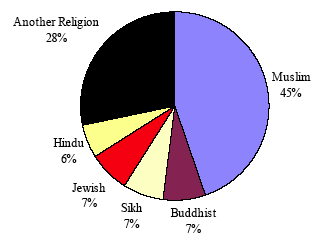
Just under half (45%) of the non-Christian religious population is made up of Muslims. The next largest non-Christian religious groups are Buddhists, Sikhs and Jews with 7% in each group. Those from other religion groups make up a significant proportion of the non-Christian group with 28% responding that they belong to a religion group out with those listed on the Census form. Further information on the write-in answers for those responding 'Another Religion' can be found in Annex A.2.
The Census religion questions (first question asked about current religion and the second asked about religion of upbringing) were both voluntary. Nevertheless, over 94% of people choose to answer the question on current religion. Around 28% of people in Scotland stated that they had no current religion.
Results from other UK Censuses suggest that people in Northern Ireland, England and Wales are more likely to identify with a religion than those in Scotland. Around 86% of people in Northern Ireland and 77% of those in England and Wales report having a religion, compared with only 67% of people in Scotland. However, it is difficult to make a direct comparison since there was only one question asked in England and Wales 'What is your religion?' as opposed to the two separate questions which were asked in Scotland. In Northern Ireland, two questions were asked but with a preliminary filter; only those people who did not regard themselves as belonging to any religion were asked to record the religion they were brought up in. Investigations by the Office for National Statistics (ONS) suggest that the responses to the question in England and Wales are most likely to reflect peoples' religion of upbringing 2 rather than whether they are currently practising in any faith. Thus it is probably more informative to compare the results from the rest of the UK with the response to the Scottish question on religion of upbringing which shows 74% reporting having been brought up in a faith.
Table 1.2 shows the different distribution of people by current religion and religion of upbringing. The largest difference between those reporting that they had a religion during upbringing and those reporting a current religion is for Christians in the Church of Scotland. Over 47% of people quoted this religion during their upbringing but only 42% list this as their current faith.
Table 1.2: Current Religion and Religion of Upbringing - All People
Column Percentages
Current Religion (%) |
Religion of Upbringing (%) |
% Difference (+/-) |
|
Church of Scotland |
42.40 |
47.27 |
4.87 |
Roman Catholic |
15.88 |
16.98 |
1.10 |
Other Christian |
6.81 |
8.38 |
1.57 |
Buddhist |
0.13 |
0.09 |
0.04 |
Hindu |
0.11 |
0.12 |
0.01 |
Jewish |
0.13 |
0.15 |
0.02 |
Muslim |
0.84 |
0.83 |
0.01 |
Sikh |
0.13 |
0.13 |
0.00 |
Another Religion |
0.53 |
0.17 |
0.37 |
All Religions |
66.96 |
74.12 |
7.16 |
No religion |
27.55 |
17.53 |
10.02 |
Not Answered |
5.49 |
8.35 |
2.86 |
All no religion / Not answered |
33.04 |
25.88 |
7.16 |
Base |
5,062,011 |
5,062,011 |
- |
Further information on how individuals' current religion differs from their religion of upbringing is provided in Table 1.3.
Table 1.3: Current religion by religion of upbringing - All People
Row Percentages
Religion of upbringing….. |
||||||||||||
Church of Scotland |
Roman Catholic |
Other Christian |
Buddhist |
Hindu |
Jewish |
Muslim |
Sikh |
Another Religion |
No Religion |
Not answered |
Base (=100%) |
|
Current religion….. |
||||||||||||
Church of Scotland |
91.7 |
.. |
2.2 |
.. |
.. |
.. |
.. |
.. |
.. |
.. |
3.8 |
2,146,251 |
Roman Catholic |
2.4 |
92.4 |
.. |
.. |
.. |
.. |
.. |
.. |
.. |
.. |
3.1 |
803,732 |
Other Christian |
11.3 |
2.2 |
77.1 |
.. |
.. |
.. |
.. |
.. |
.. |
4.8 |
4.2 |
344,562 |
Buddhist |
16.3 |
7.9 |
10.7 |
46.1 |
.. |
.. |
.. |
.. |
.. |
14.2 |
3.7 |
6,830 |
Hindu |
.. |
.. |
.. |
.. |
94.1 |
.. |
.. |
.. |
.. |
.. |
2.5 |
5,564 |
Jewish |
.. |
.. |
.. |
.. |
.. |
87.8 |
.. |
.. |
.. |
2.0 |
5.3 |
6,448 |
Muslim |
.. |
.. |
.. |
.. |
.. |
.. |
95.0 |
.. |
.. |
.. |
2.2 |
42,557 |
Sikh |
.. |
.. |
.. |
.. |
.. |
.. |
.. |
90.6 |
.. |
.. |
5.1 |
6,572 |
Another religion |
21.6 |
10.0 |
15.0 |
.. |
.. |
.. |
.. |
.. |
19.8 |
26.7 |
6.0 |
26,974 |
No Religion |
24.9 |
6.2 |
6.9 |
.. |
.. |
.. |
.. |
.. |
.. |
58.4 |
3.4 |
1,394,460 |
Not answered |
4.1 |
.. |
.. |
.. |
.. |
.. |
.. |
.. |
.. |
.. |
90.6 |
278,061 |
All Religion Groups |
47.3 |
17.0 |
8.4 |
.. |
.. |
.. |
.. |
.. |
.. |
17.5 |
8.4 |
5,062,011 |
Note: Any cells representing less than 2% have been marked with "..". They are judged to be insufficiently reliable for publication.
For the majority of religions, over 90% of people report the same religion of upbringing as their current religion. However there are some exceptions, namely, Other Christians, Buddhists, Jews, and those responding that they have another religion.
Less than half of those people who currently practise Buddhism were brought up as Buddhists (46.1%). Other religious backgrounds of those currently practising Buddhism include Church of Scotland (16.3%), Other Christian religions (10.7%) and Roman Catholic (7.9%). A further 14.2% responded that they had no religious background.
Only 77.1% of Other Christians were brought up in this grouping. The remaining people report their religious background to be Church of Scotland (11.3%) or Roman Catholic (2.2%). Another 4.8% of Other Christians responded that they had no religion during their upbringing.
Table 1.4 below shows the proportion of people responding that they have no current religion by their religion of upbringing.
Table 1.4: Proportion of people with no current religion by religion of upbringing
Percentages
Religion of upbringing |
% with no current religion |
Church of Scotland |
14 |
Roman Catholic |
10 |
Other Christian |
23 |
Buddhist |
21 |
Hindu |
5 |
Jewish |
10 |
Muslim |
2 |
Sikh |
4 |
Another Religion |
16 |
No religion |
92 |
Not answered |
11 |
All Religion Groups |
28 |
Those persons whose religious background is Other Christian are most likely to respond that they now have no current religion (23%). This is closely followed by Buddhists at 21%.
Age profiles
The age profile for each religion group is shown in Chart 1.2.
Chart 1.2: Age profile of all people by current religion - All People
Percentages
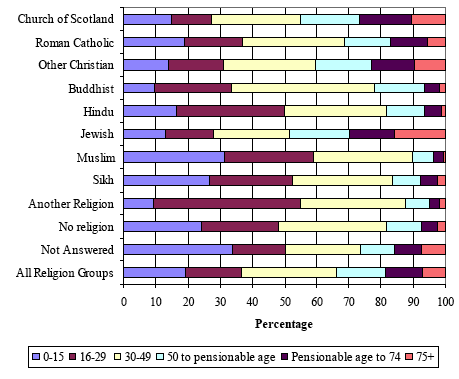
For those who answered the religion question, Muslims have the youngest age profile with 31% aged under 16 years. This is followed by Sikhs (27%) and those with no religion (24%). In contrast, the age profile of Christian and Jewish groups is much older. Over a quarter (27%) of those belonging to the Church of Scotland and 30% of Jews are of pensionable age or above. Similarly, 23% of Other Christians and 17% of Roman Catholics are within this age group. Pensionable age is 60 for women and 65 for men.
The age profiles of each religion group are shown separately for men and women in Charts 1.3 and 1.4. The Christian and Jewish groups also have the oldest age profiles for both men and women. There are, however, a greater proportion of women in these groups than there are men. For example, there are 36% of Jewish women of pensionable age and over, compared to 23% of Jewish men. Also, a third (33%) of Christian women from the Church of Scotland are of pensionable age and above, while there are 20% of Christian men from the Church of Scotland in this age group. However, this may simply reflect the fact that women live longer than men.
Chart 1.3: Age profile of men by current religion - All Males
Percentages
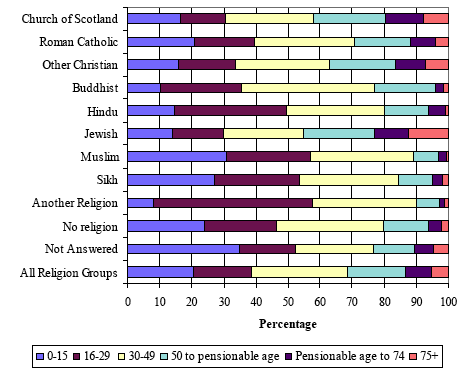
Chart 1.4: Age profile of women by current religion - All Females
Percentages
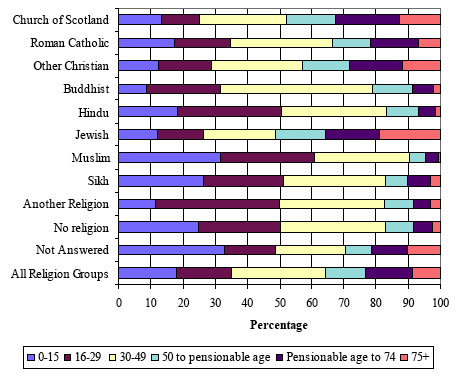
Chart 1.5 shows how the proportion of people with no religion varies with age.
Chart 1.5: Proportion of people with no current religion by sex and age, as a percentage of all people - All People
Percentages
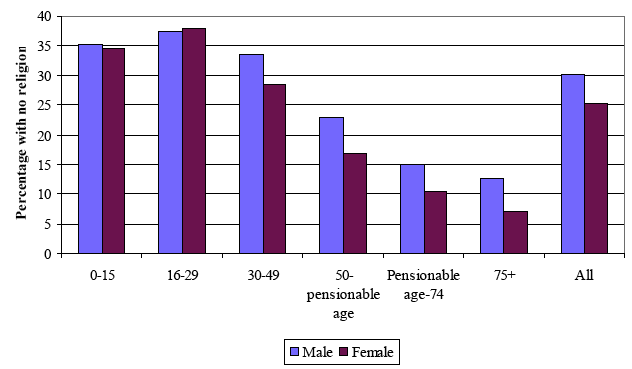
Younger people are much more likely to say they have no current religion compared to those in older age groups. The data on people with no religion presented in Chart 1.5 simply collates that presented in Charts 1.3 and 1.4, but allows you to see the relationship very clearly.
Country of Birth
Hindus are least likely to have been born in the UK with over two-thirds (70%) born outside the UK (Chart 1.6). This is followed by Muslims and Buddhists with 50% and 46% respectively being born in countries outside the UK. Virtually all people whose religious affiliation is to the Church of Scotland were born in the UK (99%).
Please refer to Annex A.3 for detailed information on the country of birth for each religion group.
Chart 1.6: Country of birth by current religion - All People
Percentages
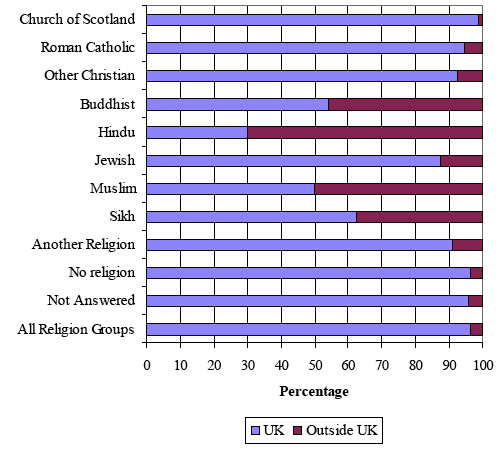
Ethnicity
Information on the ethnicity of persons from each religion group is shown in Chart 1.7. Virtually all people whose religious affiliation is to the Church of Scotland are from a White ethnic group (99.8%). The vast majority of people from the other Christian backgrounds are also White; 99.1% of Roman Catholics and 98.1% of Other Christians are from a White ethnic group. Jewish people are also primarily from a White background (96%).
Two-thirds of Muslims (67%) are of Pakistani origin. Sikhs and Hindus are predominantly Indian with 86% and 82% respectively from this ethnic group.
The most ethnically diverse religious group is Buddhism. Just over half (52%) of Buddhists are White. The remainder comprise Chinese (28%), Other Ethnic groups (14%), Other South Asian (4%), Mixed (2%) and Indian (1%).
Chart 1.7: Ethnic group by current religion - All People
Percentages
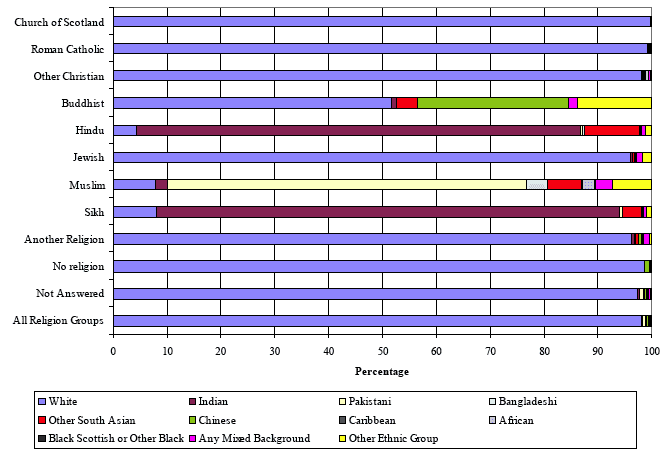
Note: The White category comprises those who responded White Scottish, Other White British, White Irish or Other White.
Chart 1.8 shows that Chinese people are the most likely to report no current religion: 63% responded that they had no current religion. Other groups reporting a high proportion of people with no current religion are Mixed (36%) and those recording their ethnicity as Caribbean (32%).
People from Pakistani and Bangladeshi ethnic groups are the most likely to respond that they are currently practising religion with only 3% and 4% respectively from each group saying that they have no religion.
Chart 1.8: Proportion of people with no current religion by ethnic group - All People
Percentages
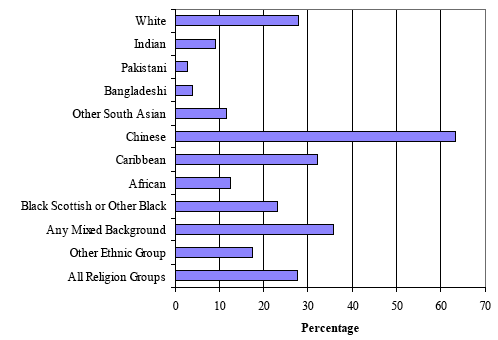
Note: The White category comprises those who responded White Scottish, Other White British, White Irish or Other White.
There are some differences across ethnic groups in terms of the age of people who responded that they have no current religion. For all ethnic groups 63% of those responding that they had no current religion were aged 29 and under, confirming the commonly held view that religiosity is related to age. However, for Indian people, only 44% of those reporting no current religion were less than 29 years old, only 50% for Pakistanis and only 40% for Caribbean people. (This information is not contained within a table or chart).
Marital status
Muslims and Sikhs are most likely to be married, with 58% of those aged 16 and over being in their first marriage. Over half of Hindus (57%) aged 16 plus are also married.
Hindus, Sikhs and Muslims are least likely to be re-married, separated or divorced.
Those most likely to be widowed include Jewish people (13%), those whose affiliation is to the Church of Scotland (12%) and Other Christians (10%). This can be expected given the older age profiles of these groups as shown in Chart 1.2.
Table 1.5: Marital Status by current religion - All People aged 16 years and over
Row percentages
Single (never married) |
Married (First Marriage |
Re-married |
Separated |
Divorced |
Widowed |
Base |
|
Church of Scotland |
23 |
49 |
6 |
3 |
7 |
12 |
1,827,740 |
Roman Catholic |
33 |
43 |
4 |
4 |
7 |
9 |
651,607 |
Other Christian |
26 |
47 |
7 |
3 |
6 |
10 |
296,815 |
Buddhist |
40 |
37 |
5 |
4 |
11 |
3 |
6,182 |
Hindu |
34 |
57 |
2 |
2 |
2 |
3 |
4,653 |
Jewish |
27 |
45 |
6 |
2 |
7 |
13 |
5,615 |
Muslim |
30 |
58 |
3 |
4 |
3 |
2 |
29,238 |
Sikh |
28 |
58 |
3 |
3 |
3 |
5 |
4,822 |
Another Religion |
61 |
23 |
4 |
3 |
6 |
2 |
24,485 |
No religion |
42 |
37 |
6 |
4 |
8 |
4 |
1,055,027 |
Not Answered |
37 |
36 |
5 |
4 |
8 |
11 |
183,762 |
All Religion Groups |
31 |
44 |
6 |
4 |
7 |
9 |
4,089,946 |
Table 1.6 shows, by sex, the proportion of married individuals who fall into each of the main faith groups. It can be seen that one quarter of all married men report having no current faith compared with just under one fifth of married women. Thus there are slightly higher proportions of females than males in the three Christian groups but no significant differences in any of the other categories.
Table 1.6: Religion of individuals in married couples by sex and current religion - All married couples in households
Column Percentages
Males |
Females |
|
Church of Scotland |
48.0 |
51.5 |
Roman Catholic |
14.3 |
15.7 |
Other Christian |
7.4 |
8.5 |
Buddhist |
0.1 |
0.1 |
Hindu |
0.1 |
0.1 |
Jewish |
0.1 |
0.1 |
Muslim |
0.8 |
0.8 |
Sikh |
0.1 |
0.1 |
Another Religion |
0.4 |
0.3 |
No Religion |
25.0 |
19.3 |
Not Answered |
3.6 |
3.5 |
All Religion Groups |
998,743 |
998,743 |
Table 1.7 shows the same information for co-habiting couples of opposite sex.
Table 1.7: Religion of individuals co-habiting by sex and current religion - All co-habiting couples of opposite sex in households
Column Percentages
Males |
Females |
|
Church of Scotland |
29.7 |
31.4 |
Roman Catholic |
13.9 |
14.7 |
Other Christian |
4.9 |
5.9 |
Buddhist |
0.2 |
0.1 |
Hindu |
0.0 |
0.0 |
Jewish |
0.1 |
0.1 |
Muslim |
0.2 |
0.2 |
Sikh |
0.1 |
0.0 |
Another Religion |
1.3 |
0.8 |
No Religion |
44.7 |
42.6 |
Not Answered |
4.8 |
4.2 |
All Religion Groups |
160,379 |
160,379 |
There are much higher proportions of both co-habiting men and women who report having no current religion than for married couples. These differences may, however, be explained by the fact that married couples will generally be older than co-habiting couples.
Once again, there are a slightly higher proportion of men reporting no religion than women (although the difference is smaller than for married couples).
Religion of spouse
Table 1.8 and 1.9 shows the religions of married spouses and opposite sex co-habiting couples respectively; each column of the table shows data for couples where at least one member of the couple is from that religion. For example, for couples where at least one is Church of Scotland, 13.1% of couples are Church of Scotland/No Religion, 68.5% are both Church of Scotland, and 11.2% of couples are Church of Scotland/Roman Catholic. Couples where both spouses report the same religion will only appear once in the table (along the diagonal) but couples with different religious backgrounds will appear twice. This allows the profile for each religion group to be looked at separately.
Table 1.8: Religion of married couples by current religion - All married couples in households
Column Percentages
At least one partner is… |
Church of Scotland |
Roman Catholic |
Other Christian |
Buddhist |
Hindu |
Jewish |
Muslim |
Sikh |
Another Religion |
No Religion |
Not Answered |
Religion of other partner: |
|||||||||||
Church of Scotland |
68.5 |
31.3 |
27.6 |
15.8 |
6.3 |
11.1 |
4.7 |
3.7 |
17.9 |
26.3 |
21.3 |
Roman Catholic |
11.2 |
42.3 |
9.3 |
6.2 |
3.9 |
5.8 |
3.0 |
2.6 |
7.2 |
13.7 |
8.9 |
Other Christian |
5.1 |
4.9 |
43.9 |
6.2 |
3.5 |
5.7 |
1.6 |
3.0 |
13.4 |
5.9 |
5.9 |
Buddhist |
0.1 |
0.1 |
0.1 |
29.7 |
0.6 |
0.2 |
0.1 |
0.1 |
0.5 |
0.2 |
0.2 |
Hindu |
0.0 |
0.0 |
0.0 |
0.5 |
68.9 |
0.1 |
0.2 |
1.2 |
0.2 |
0.0 |
0.2 |
Jewish |
0.0 |
0.0 |
0.1 |
0.2 |
0.1 |
55.3 |
0.1 |
0.7 |
0.2 |
0.1 |
0.3 |
Muslim |
0.1 |
0.1 |
0.1 |
0.4 |
1.4 |
0.3 |
79.7 |
0.8 |
0.4 |
0.2 |
0.9 |
Sikh |
0.0 |
0.0 |
0.0 |
0.1 |
1.3 |
0.6 |
0.1 |
75.7 |
0.1 |
0.0 |
0.2 |
Another Religion |
0.2 |
0.2 |
0.6 |
1.4 |
0.6 |
0.7 |
0.2 |
0.3 |
23.6 |
0.5 |
0.8 |
No Religion |
13.1 |
19.0 |
15.7 |
35.1 |
7.2 |
13.1 |
5.5 |
4.6 |
29.2 |
50.8 |
13.8 |
Not Answered |
1.7 |
2.0 |
2.6 |
4.4 |
6.2 |
7.1 |
4.8 |
7.2 |
7.4 |
2.3 |
47.6 |
Base |
589,789 |
210,279 |
109,918 |
1,900 |
1,464 |
1,807 |
8,999 |
1,533 |
5,069 |
293,219 |
48,103 |
Muslims have the highest rate of 'same religion' marriages: 80% of couples where at least one of the spouses is Muslim are Muslim/Muslim marriages. Sikhs have a similarly high rate of 'same religion' marriages (76%). Buddhists have the lowest rate of 'same religion' marriages: only 30% of marriages involving Buddhists are Buddhist/Buddhist marriages, and a higher proportion of Buddhists are married to people who report no current faith. 69% of marriages where one spouse is Church of Scotland are Church of Scotland/Church of Scotland marriages compared with 42% of marriages involving at least one Roman Catholic being Roman Catholic/Roman Catholic marriages.
Table 1.8 presented data on the faiths within a marriage regardless of sex. Examination of these data by sex of the spouse reveals some different patterns between different religion groups. For example, for marriages where one partner is Church of Scotland and the other is Roman Catholic, it is equally likely to be the man who is Church of Scotland (or Roman Catholic) as the woman. However, of the marriages involving one partner who is Church of Scotland and the other Muslim, there are eight times as many marriages where it is the woman who is Church of Scotland and the man is Muslim than the other way around. Annex A.4 provides a full breakdown of the religion of married couples by sex.
There is a problem
Thanks for your feedback